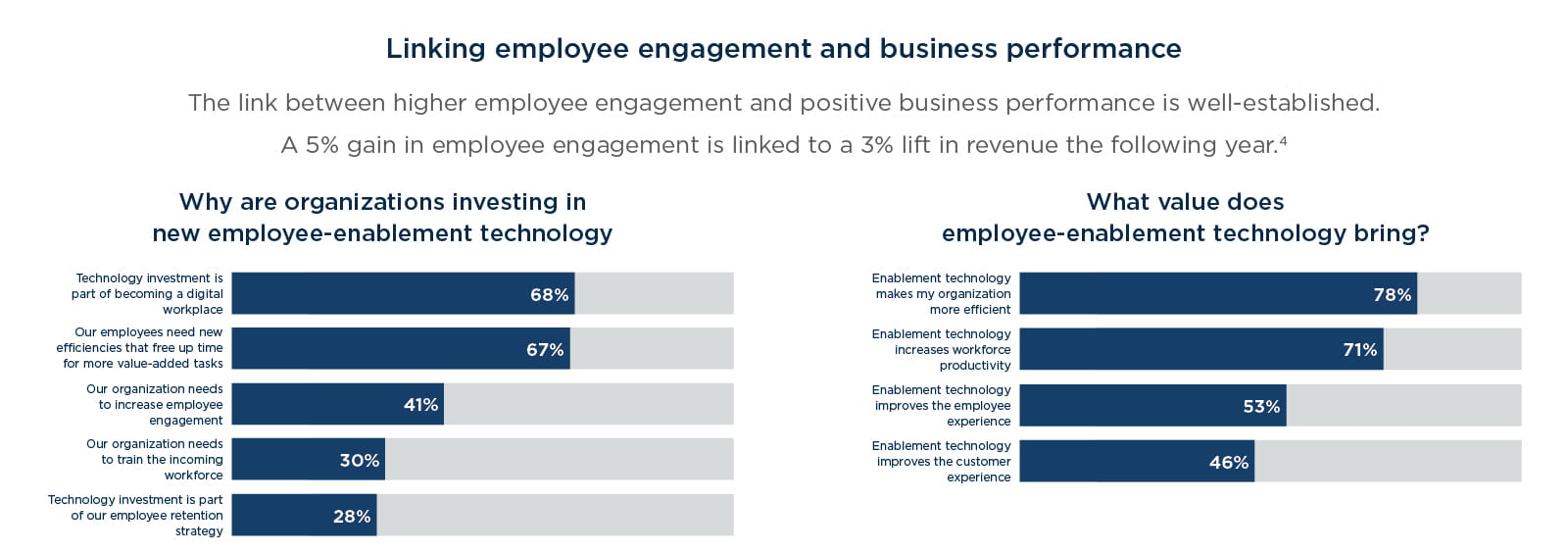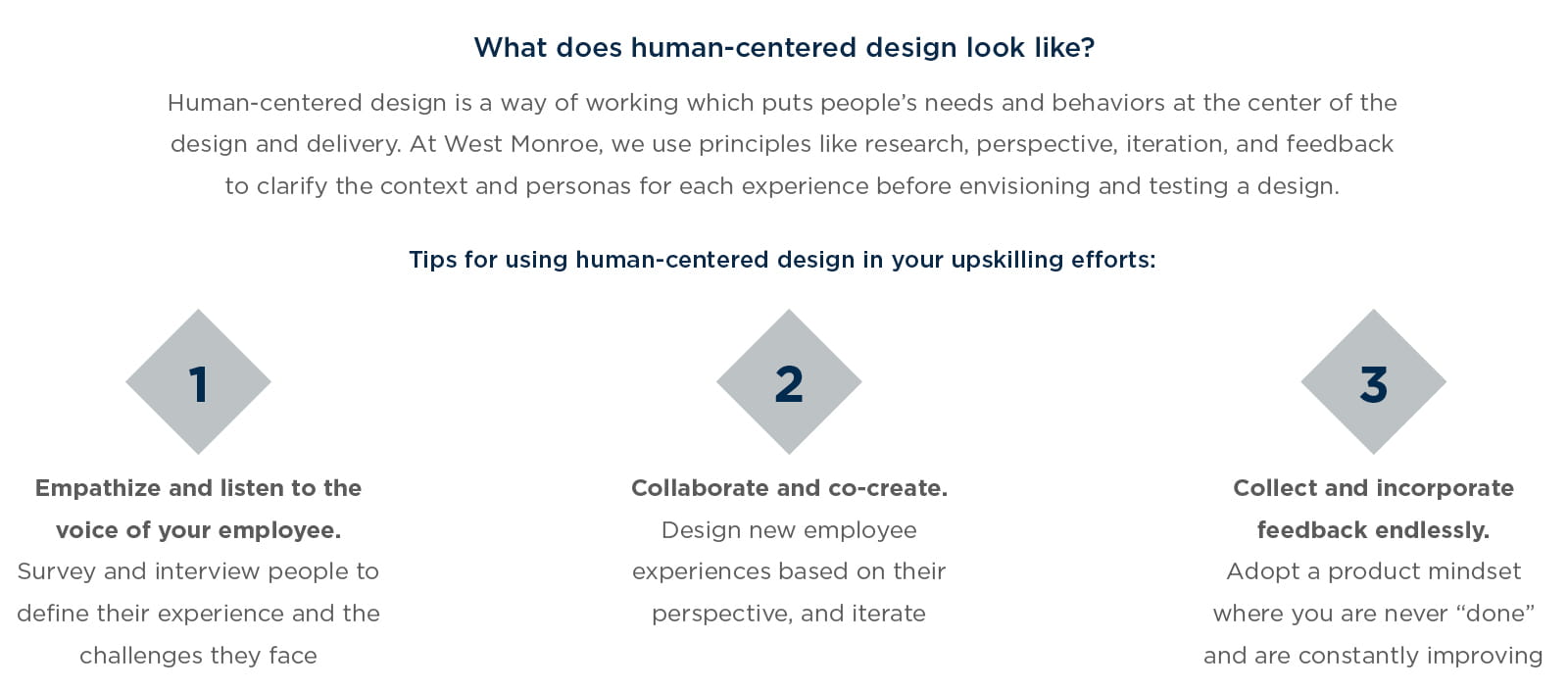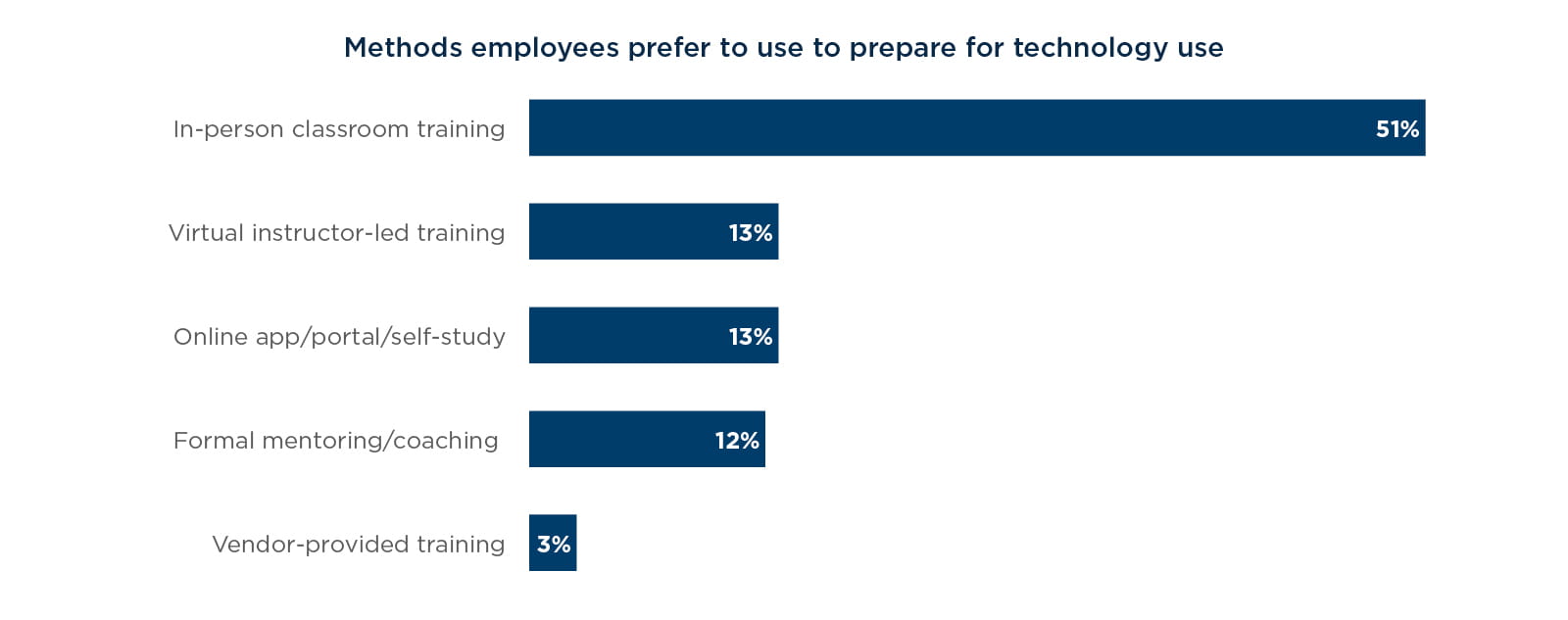
September 2019 | Signature Research
The Upskilling Crisis: The Benefits of Enabling and Retraining Employees for the Future
Research reveals that upskilling is an answer for a looming workforce crisis: Leaders and employees are concerned about skills gaps worsening in the future
get the full reportEmployers and employees agree there is a need for upskilling, and both want more from their managers.
In our surveys of 432 HR professionals (manager level and above) and 1,000 U.S. workers, we found that employers and employees both recognize that work is becoming digital first and this new environment requires updated skills. Managers hold the key to successful upskilling—however, many organizations are falling short. Here are some of the key findings from our survey.
- New skills are necessary to ensure profitability: 61% of survey respondents agree that technology helps them deliver a higher quality of work output. While current employees may lack certain skills, they are still the best resource to tackle disruption and prevent a skills crisis (when the need will be too critical to solve quickly). Employees are aware of their own abilities, and they expect their employers will reskill them.
- Many employers believe they have a skills gap: Many survey respondents believe there’s a significant skills gap at their organizations; 56% of survey respondents say their organization’s skills gap is moderate to severe. Only 6% say they don’t have a skills gap at all.
- Organizations are missing the mark on taking a human-centered approach to upskilling: Before implementing any sort of enablement technology, organizations need to consider the employee journey and how a selected tool will add value; 84% of respondents say they sometimes or never redesign this journey before onboarding new technology while only 16% say they always do.
- Managers are crucial to success: Enabling managers will be key to addressing adoption, disruption, and upskilling challenges; 63% of survey respondents say their organization has not equipped its managers with upskilling resources. When managers have the proper skills training and resources, they spend less time on low-level tasks and are equipped to develop their teams.

Introduction
With the war for talent in full force and the very nature of work changing, organizations are recognizing the need to upskill their workforce.
As automation grows in every part of the workplace, it becomes increasingly important to direct employees’ time toward higher-value work. Upskilling also comes at a time when emerging skill sets are scarce and the talent market is tight, making it prudent to keep people even if they don’t currently have the right skills. Indeed, it’s often cheaper to retrain current employees than find and hire new ones, as the consequences of turnover (forced or not) can be felt at the bottom line: Forrester reports that each standard deviation increase in turnover results in a 40% reduction in profit.
The attention to upskilling is happening very broadly, regardless of organizational size or industry. Amazon recently announced a major upskilling investment of more than $700 million that aims to reskill a third of its U.S. workforce over the next six years, in response to increasing workplace automation.
While not every organization can address the upskilling crisis at this scale, most have taken the initial step of introducing new employee enablement technologies. That’s because there is clear consensus on employee enablement technology’s role in upskilling: In this digital age, it is essential to free up employees’ time to work on more strategic tasks, boost output and productivity, and ultimately increase revenue through improved experiences.
We explore the attitudes and actions employers and employees have adopted regarding skills gaps and the upskilling crisis. We asked: How serious is your organization’s skills gap? What challenges prevent employee enablement technology adoption? And what makes some organizations successful while others fall flat?
Chapter 1: Organizations are taking steps to mitigate the effects of disruption
As the nature of work evolves, job roles fluctuate exist five years ago are suddenly sought after, requiring employees to develop new capabilities to meet the challenges of those positions. Amazon recognized this during a recent audit of its open roles. From 2014 to 2018, the word robotics saw a 30-fold increase in appearance in job titles, while job titles including the word technologist increased by 91%. So much work is happening in the digital space that companies not preparing for this shift in job functions risk not hiring for the right skill sets.
What’s more: As workplaces shift toward a digital-first mindset, all employees need to be more tech-savvy to perform even the most basic tasks across communication, record-keeping, training, and more. An increase in user- friendly technology—such a digital intranet or new CRM system—is meant to save employees time, but that only happens when employees have the right skills and training to adopt the tools and use them well.
70% of surveyed organizations have introduced at least one new technology to increase employee capacity in the past year.
To address the upskilling crisis, employers will need to both train employees in new areas and provide enablement technologies to boost their current productivity. Given this environment, it’s no surprise that 70% of surveyed organizations have introduced at least one new technology to upskill employees and increase capacity in the past year.

Featured Content
The productivity imperative: Gaining ground in economic booms and recessions
Read MoreImplementing new technologies to address challenges
As work processes evolve, both the employee and customer experiences change. Tasks previously done manually are now digitized. Customer interactions are frequently done online rather than face-to-face. All of these new ways of working are part of the digital workplace.
When one of these areas is out of sync, both the employee and the customer experience suffers and organizations risk losing business and market share.

There’s an overwhelming consensus on what motivates organizational investment in employee enablement technologies: 68% say tech investments are simply “a part” of becoming a digital workplace, and 67% say employees need new efficiencies that free up their time for more valuable tasks. For 41% of respondents, increasing employee engagement is a motivating factor.
These motivations feed into the desire to improve both the employee and customer experiences, which in turn generate business value. According to respondents, the benefits they’ve experienced from recent implementations largely mirror these motivations.
Specifically, 78% of respondents say their recent technology initiative has allowed workers to be more efficient and judicious with their time. Further, 71% say the new technology has increased workplace productivity, while 53% believe the new technology has improved the employee experience.
Are employers and employees in sync?
Do employees agree with this assessment? Some do.
Many have been tasked with learning a variety of different technologies in the past year—from conventional hardware to communications tools. Of these employees, 61% agree that technology helps them deliver a higher quality of work output. Further, 56% say technology allows them to work more efficiently and frees their time for additional tasks.
However, there are challenges. Some organizations are failing their employees—particularly regarding upskilling training. Thirty-three percent of employees say they were never trained on the new technologies they’ve been tasked with using. If one in three employees isn’t getting trained, this will impede adoption and stifle business outcomes.
To gain further understanding of the challenges to wide- scale technology implementation and use, we must examine the choke points to upskilling. This starts with a strategy that doesn’t consider the human experience, employee resistance to adoption, and a lack of the right management skills.
Chapter 2: Using a human-centered approach to understand and address adoption challenges
While technology is necessary for upskilling your workforce, its benefits can only be recognized when people use it effectively. Before organizations put any new technology in place, it is imperative that they think about the end-user experience: how employees will consume the new technology, why it will enable them to do their jobs better, and what paths they can take to build the necessary skills. Applying a human-centered design approach to answering these questions is crucial to realizing ROI on upskilling efforts.
A human-centered approach to upskilling cannot be an afterthought as it affects the employee experience, which has a direct impact on customer experience. When shopping for tools to drive productivity, the employee experience might not be at the forefront. But user experience is everything. For example, technology evolution has led employees to expect that their digital processes will run smoothly—and they won’t use anything that’s clunky, counterintuitive, or more time-consuming than their current process. Organizations that recognize the need for a smooth user experience and apply human-centered thinking to any new technology or process will win.

Organizations that don’t put their people at the center of an upskilling initiative run the risk of rolling out a program only to have it fail by lack of adoption. This isn’t a remote possibility. According to our survey, employee adoption is the biggest roadblock to implementing new employee enablement technologies.
Without proper manager training and employee adoption, technology is likely to go nowhere. Adoption needs to happen at all levels of the businesses—from the C-suite down to the line level. Leaders especially need to own the change, encourage adoption, and be aware of adoption challenges. Leaders who resist change (or who are unable to train their employees) risk becoming an internal roadblock to organizational transformation.
Identifying adoption solutions
Fortunately, there are strategies and approaches that can help overcome these roadblocks. Incorporating effective change management programs can mitigate a cultural resistance to change to upskilling. This includes maintaining transparency and communications to help the workforce understand what’s happening with the change and what’s expected of employees.
Change management should also be prioritized over technology implementation. Change isn’t always easy— 24% of respondents say an inability to either identify or communicate the need for new technology is a roadblock. But communication is necessary for employees to both understand the challenges the organization faces, and their role in meeting those challenges head-on.
With employee engagement stubbornly low, organizations should look for ways to improve the employee experience. One possible approach is to be aware of how receptive employees are to specific learning modalities and adjust delivery methods accordingly. By a wide margin, employees favor in-person classroom training over all other learning modalities. While this type of training is often the most expensive, organizations may need to consider how to incorporate in-person training as a blended solution with virtual training to increase employee engagement and adoption of upskilling initiatives.
When prioritizing training investments, it might be tempting to record a training video, hit “send” to all employees, and call it a day. However, employers should look to in-person trainings for more significant upskilling opportunities and leverage other e-learning modules when appropriate for smaller changes. The investment in training types that employees prefer should speed up adoption and allow employees to realize value faster.
Key insight: Let managers lead
When developing upskilling programs, remember this: Empowering managers to lead during times of change is critical. And too many administrative tasks prevent managers from using their time to the fullest.
When West Monroe worked with a national transportation company, we found that managers weren’t spending enough time engaging with and developing their teams. While the company expected managers to spend 45% of their time engaging with their employees, this happened less than 15% of the time. To unlock more time for managers, we highlighted the key issues managers encountered and recommended new processes to address distractions—and let managers lead.
With any upskilling initiative, organizations should focus on empowering their managers. Technology adoption won’t happen in a vacuum. Employees need training on both technology and strategic work, and this is where manager enablement and support is crucial.
Managers need to have the time and tools to encourage and mentor their employees in upskilling efforts. Managers also drive productivity, which means work runs smoothly when managers themselves are equipped to perform these tasks and slows down when they aren’t.

Featured Content
Companies are Overlooking a Primary Area for Growth and Efficiency: Their Managers
Read MoreThe positive outcomes to this loop of technology, upskilling, and manager enablement include transforming a workforce into one that’s more empowered and agile. Employee engagement levels rise when workers feel secure and empowered at their jobs.
Engagement also translates to bottom-line ROI in the form of improved customer satisfaction. Forrester research reports that companies with happy employees have 81% higher customer satisfaction and 50% lower turnover rates. By upskilling current employees rather than buying needed skill sets, organizations save money on hiring and training new employees. The next step is to discover where and how organizations have skills gaps.
Chapter 3: Addressing the skills gap
When viewing skills acquisition and reskilling through the traditional lens of build, buy, borrow, it’s interesting to note how trends have shifted over time. When unemployment rates were high, organizations were more content to buy or borrow talent, hiring workers as fast as they could and outsourcing other tasks. However, with the United States at historically low unemployment levels and outsourcing becoming a less viable option, more and more organizations are pivoting to a “build” mentality.
Training the current workforce will have many positive outcomes in the long run, such as improved employee experiences, customer experiences, and knowledge retention. But moving to a build mentality takes time. It’s important that organizations take stock of where their employees are and what it will take to get them sufficiently upskilled. Another recent survey found that by 2022, 54% of all employees will need significant reskilling or upskilling, as their current skills become outdated.
Assessing your own workforce
Indeed, 60% of surveyed employees think their current skill set will be outdated in the next three to five years. When asked “why” they pointed to several pressures, including the need to learn new technology (55%), automation replacing their skill set (32%), and the skillset in their role growing more complex (25%). Of the employees that will need reskilling by 2022, 35% of them will need training that could take up to six months, while 10% will require training that could take more than a year.
Many HR respondents agree with this assessment and believe there’s a significant skills gap at their organizations.
Fifty-six percent of survey respondents say their organization’s skills gap is moderate to severe. Only 6% say they don’t have a skills gap at all.
How do you know what type of upskilling your workforce needs—and how much? Skills gap assessments give more granular insight into where organizations need to shore up their employees’ skills and competencies. Fifty-one percent of respondent organizations have performed such assessments in the past 12 months, with 33% planning to do so in the next 12 to 18 months.
Employers also need to understand how current and future members of the workforce feel about upskilling and the employer role in employee development. While the desire for development isn’t limited to the newest employees, organizations need to be aware of just how much younger workers understand the realities of skills decay and the need for professional development. For example, Millennials can expect to need reskilling more than a dozen times during their career. Also, a recent survey of Gen Z workers found that 9 out of 10 cited professional development as one of their top factors when choosing a potential employer.
How can organizations prepare for employee expectations around upskilling?
Change is coming. Organizations should recognize not only that they need to change to remain competitive in today’s market, but their employees also see the change coming. However, employees expect that organizations will prepare them for upcoming changes and organizations must recognize their role in employee development. If organizations don’t have a plan for upskilling employees, employees will go elsewhere.
The employer’s role in upskilling
Employees also assume that employers will invest in them. Fifty-eight percent of employees believe that if they need to develop new skills, employers will both tell employees and invest in their development. Only 24% of employees believe employers should expect employees to develop at their own expense.
Throughout all this development, managers are the key to ensuring employees have relevant, transferable skills. However, a lack of leadership and direction is another potential stumbling block to adopting new technologies. Sixty-five percent of respondents feel those responsible for leading the way (managers and senior leaders) need reskilling themselves.
These results strongly support the idea that there needs to be significant investment in manager development and enablement if organizations are to expect increased profitability through digitization. However, another West Monroe survey found that 59% of managers overseeing one to two people received no training at all and 42% took to mimicking the managerial style of a former boss.
Adoption and change need to come from the top. Any upskilling program should take this into account: Upskilling and reskilling should happen at all levels.
To remove the roadblocks associated with technology adoption and upskilling, organizations need to make employees feel comfortable about change. At the same time, employers need to be aware of these employee expectations and address them if organizations are going to increase employee engagement and adoption in enablement technologies. Employers have an opportunity to take the lead in developing their employees in exactly what they want them to be.
Further Reading
Conclusion
Time is of the essence when it comes to upskilling and reskilling. Upskilling your workforce is an imperative in the coming years—to win the war for talent, maximize productivity, and remain at the forefront of digital transformation.
It’s often more cost-efficient to retrain current employees than go out to try and find new ones. Many organizations are beginning to shift from a buy to a build mentality and they’ll need adequate technologies in place to assist employees with the upskilling and reskilling transition. Potential employees can’t be ignored, though; younger workers are all too aware of evolving skill sets and will prioritize working for the organizations that will develop them.
Training and upskilling centered around the human experience brings the potential of increased employee engagement, retention, growth, and profitability. To realize lasting value, quicker, organizations must design the upskilling experience with their employees at the center. That lens will create awareness around expectations employees place on them, as well as the potential roadblocks to any employee enablement efforts. Only then can a technology or tool provide value back to the organization, such as streamlined processes, recognizable ROI, or improved customer experience.
West Monroe is uniquely positioned to help organizations face these challenges head-on and realize their vision of a better skilled workforce. New technologies will require awareness of and investment in human-centered design, change management, and manager enablement to ensure adoption and realize value.







